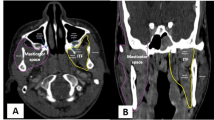Abstract
Background
Olfaction is an undervalued sense in neurosurgery. Attempted surgical resection of anterior cranial fossa meningiomas puts the olfactory pathway at risk. Preservation of olfaction may increase the postoperative quality of life. Objective assessment of olfaction may inform clinical decision-making and influence the selection of operative approaches for surgical resection.
Methods
We reviewed all patients who underwent surgical resection for midline anterior skull base meningiomas from July 1, 2014, through December 31, 2017. Patient demographics, tumor size, operative approach, pre- and postoperative deficits, and Simpson grade were collected and analyzed. Postoperative olfaction was assessed by clinical evaluation as well as objective evaluation using the University of Pennsylvania Smell Identification Test (UPSIT).
Results
Twenty-eight patients (10 male, 18 female) were included with an average age of 53.8 years (range 27–80 years). Twenty-six patients underwent craniotomy for resection, while 2 patients had endoscopic approaches. Average tumor volume was 402.1 cm3 (6.6–2507.7 cm3). Preoperatively, five patients (17.8%) presented with olfactory impairment. Objectively, 50% of patients (14/28) consented and completed the UPSIT. The average postoperative UPSIT score was 25.8/40 (9/40–38/40). Two patients not identified on clinical assessment alone demonstrated postoperative olfactory deficit on UPSIT (2/14).
Conclusion
There are limited published studies evaluating olfaction in patients who undergo skull-based approaches for anterior fossa meningiomas. Our series showed the highest olfaction preservation rate (87.5%) using a comprehensive strategy and multitude of surgical approaches based on the olfactory function and tumor characteristics.




Similar content being viewed by others
Change history
26 February 2019
Result is incorrect.
References
Brand G, Jacquot L (2001) Quality of odor and olfactory lateralization processes in humans. Neurosci Lett 316:91–94. https://doi.org/10.1016/s0304-3940(01)02375-8
Savic IB, Hans B (2000) Right-nostril dominance in discrimination of unfamiliar, but not familiar, odours. Chem Senses 25:517–523
Banu MA, Mehta A, Ottenhausen M, Fraser JF, Patel KS, Szentirmai O, Anand VK, Tsiouris AJ, Schwartz TH (2016) Endoscope-assisted endonasal versus supraorbital keyhole resection of olfactory groove meningiomas: comparison and combination of 2 minimally invasive approaches. J Neurosurg 124:605–620. https://doi.org/10.3171/2015.1.JNS141884
de Almeida JR, Carvalho F, Vaz Guimaraes Filho F, Kiehl TR, Koutourousiou M, Su S, Vescan AD, Witterick IJ, Zadeh G, Wang EW, Fernandez-Miranda JC, Gardner PA, Gentili F, Snyderman CH (2015) Comparison of endoscopic endonasal and bifrontal craniotomy approaches for olfactory groove meningiomas: a matched pair analysis of outcomes and frontal lobe changes on MRI. J Clin Neurosci : Official Journal of the Neurosurgical Society of Australasia 22:1733–1741. https://doi.org/10.1016/j.jocn.2015.03.056
Doty RL, Shaman P, Kimmelman CP, Dann MS (1984) University of Pennsylvania Smell Identification Test: a rapid quantitative olfactory function test for the clinic. Laryngoscope 94:176–178
Jang WY, Jung S, Jung TY, Moon KS, Kim IY (2013) Preservation of olfaction in surgery of olfactory groove meningiomas. Clin Neurol Neurosurg 115:1288–1292. https://doi.org/10.1016/j.clineuro.2012.12.004
Koutourousiou M, Fernandez-Miranda JC, Wang EW, Snyderman CH, Gardner PA (2014) Endoscopic endonasal surgery for olfactory groove meningiomas: outcomes and limitations in 50 patients. Neurosurg Focus 37:E8
Ramakrishnan VR, Suh JD, Chiu AG, Palmer JN (2011) Septal dislocation for endoscopic access of the anterolateral maxillary sinus and infratemporal fossa. Am J Rhinol Allergy 25:128–130. https://doi.org/10.2500/ajra.2011.25.3559
Rosen MR, Rabinowitz MR, Farrell CJ, Schaberg MR, Evans JJ (2014) Septal transposition: a novel technique for preservation of the nasal septum during endoscopic endonasal resection of olfactory groove meningiomas. Neurosurg Focus 37:E6. https://doi.org/10.3171/2014.7.FOCUS14308
Youssef AS, Sampath R, Freeman JL, Mattingly JK, Ramakrishnan VR (2016) Unilateral endonasal transcribriform approach with septal transposition for olfactory groove meningioma: can olfaction be preserved? Acta Neurochir 158:1965–1972
Greig SR, Cooper TJ, Sommer DD, Nair S, Wright ED (2016) Objective sinonasal functional outcomes in endoscopic anterior skull-base surgery: an evidence-based review with recommendations. Int Forum Allergy Rhinol 6:1040–1046. https://doi.org/10.1002/alr.21760
Ottenhausen M, Rumalla K, Alalade AF, Nair P, La Corte E, Younus I, Forbes JA, Ben Nsir A, Banu MA, Tsiouris AJ, Schwartz TH (2018) Decision-making algorithm for minimally invasive approaches to anterior skull base meningiomas. Neurosurg Focus 44:E7. https://doi.org/10.3171/2018.1.FOCUS17734
Adegbite AB, Khan MI, Paine KWE, Tan LK (1983) The recurrence of intracranial meningiomas after surgical-treatment. J Neurosurg 58:51–56. https://doi.org/10.3171/jns.1983.58.1.0051
Li MS, Portman SM, Rahal A, Mohr G, Balasingam V (2014) The lion's mane sign: surgical results using the bilateral fronto-orbito-nasal approach in large and giant anterior skull base meningiomas. J Neurosurg 120:315–320. https://doi.org/10.3171/2013.11.JNS13552
Downes AE, Freeman JL, Ormond DR, Lillehei KO, Youssef AS (2015) Unilateral tailored fronto-orbital approach for giant olfactory groove meningiomas: technical nuances. World Neurosurg 84:1166–1173. https://doi.org/10.1016/j.wneu.2015.05.011
Ung TH, Waziri AE, Ramakrishnan VR (2014) Preoperative ethmoid artery ligation facilitates resection of large sub-frontal meningiomas. Am J Otolaryngol 35:424–426. https://doi.org/10.1016/j.amjoto.2014.01.003
Bassiouni H, Asgari S, Stolke D (2007) Olfactory groove meningiomas: functional outcome in a series treated microsurgically. Acta Neurochir 149:109–121; discussion 121. https://doi.org/10.1007/s00701-006-1075-z
Gande A, Kano H, Bowden G, Mousavi SH, Niranjan A, Flickinger JC, Lunsford LD (2014) Gamma knife radiosurgery of olfactory groove meningiomas provides a method to preserve subjective olfactory function. J Neuro-Oncol 116:577–583. https://doi.org/10.1007/s11060-013-1335-8
Author information
Authors and Affiliations
Corresponding author
Ethics declarations
Conflict of interest
The authors declare that they have no conflict of interest.
IRB approval
17-1887
Ethical approval
All procedures performed in studies involving human participants were in accordance with the ethical standards of the institutional and/or national research committee (name of institute/committee) and with the 1964 Helsinki declaration and its later amendments or comparable ethical standards. For this type of study formal consent is not required.
Additional information
Publisher’s note
Springer Nature remains neutral with regard to jurisdictional claims in published maps and institutional affiliations.
This article is part of the Topical Collection on Brain Tumors
Rights and permissions
About this article
Cite this article
Ung, T.H., Yang, A., Aref, M. et al. Preservation of olfaction in anterior midline skull base meningiomas: a comprehensive approach. Acta Neurochir 161, 729–735 (2019). https://doi.org/10.1007/s00701-019-03821-8
Received:
Accepted:
Published:
Issue Date:
DOI: https://doi.org/10.1007/s00701-019-03821-8




